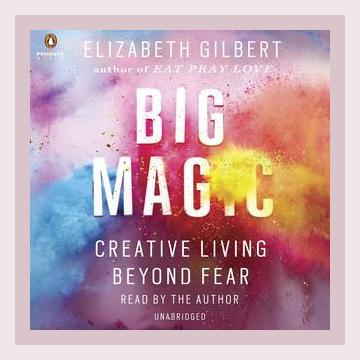Innovation and CreativityCreativity in Business
“Big Magic: Creative Living Beyond Fear,” authored by Elizabeth Gilbert in 2015, delves into the mysteries of creativity and provides insights on how to navigate the often turbulent waters of creative endeavors. This book, a beacon to both seasoned artists and those embarking on creative journeys, is divided into six sections: Courage, Enchantment, Permission, Persistence, Trust, and Divinity.
I. Courage
Gilbert opens by stressing the importance of courage in creative work. Fear is a primitive reaction that often inhibits creative endeavors.
- Example: Gilbert shares her own experience of being paralyzed by fear in her writing career and how she overcame it by accepting fear as part of the process.
- Action: Embrace Fear – Allow yourself to acknowledge fear instead of trying to eliminate it. Make a pact with your fear that it can come along for the ride, but it doesn’t get to drive the creative process.
II. Enchantment
Creativity is often viewed as a mystical force; Gilbert refers to this as “Big Magic.” The idea is to see inspiration as a magical, almost otherworldly entity that interacts with us.
- Example: Gilbert tells the story of an idea for a novel that she abandoned, which subsequently appeared in a different form in the works of another author.
- Action: Stay Open to Ideas – Keep a journal or a digital note file where you write down every creative idea that comes to you, no matter how whimsical or improbable.
III. Permission
One of the biggest barriers to creativity is seeking external validation or permission. Gilbert insists that individuals must give themselves permission to be creative.
- Example: She mentions the story of her friend who became a figure skater again in her forties, simply because she gave herself permission to pursue this joy.
- Action: Grant Yourself Permission – Start a project that you’ve been yearning to do without waiting for approval from others. Grant yourself the freedom to explore your passions.
IV. Persistence
Persistence underpins any successful creative endeavor. Gilbert states that creativity is less about talent and more about persistence.
- Example: She talks about the years of rejection letters she accumulated for her manuscripts before achieving success with “Eat, Pray, Love.”
- Action: Set a Routine – Establish a daily or weekly routine dedicated to your creative work. This consistency will help build the momentum needed to tackle larger projects.
V. Trust
Trust in your own creative instincts and the process itself is crucial. This includes trusting that the universe supports and believes in your creative journey.
- Example: Gilbert recounts how she trusted her instincts to leave her job and travel, which led to her writing one of her most successful books.
- Action: Act on Intuition – When you feel an intuitive pull toward a certain project or idea, trust that feeling and take steps toward actualizing it.
VI. Divinity
Creativity, to Gilbert, is a divine force. She ties creativity to the divine, suggesting that understanding this connection facilitates a deeper level of creative freedom.
- Example: Gilbert’s reflection on how Renaissance artists like Michelangelo perceived their creativity as an interaction with the divine.
- Action: Create a Sacred Space – Designate a space in your home as a creative sanctuary where you can connect with your inner creativity free from distractions.
Detailed Examples and Actions:
Courage
- Example 1: Gilbert recounts her friend who aspired to return to figure skating. Despite societal norms suggesting otherwise, her friend embraced her fear and pursued her passion.
- Action: Confront a Fear Directly – List your creative fears and systematically work through them by engaging in small tasks that help diminish those fears over time.
Enchantment
- Example 2: The tale of the poet Ruth Stone, who felt poems coming at her from over the landscape, inspiring her to “catch them” before they passed.
- Action: Stay Receptive – Practice mindfulness and be more observant in your daily life to catch and nurture these fleeting moments of inspiration.
Permission
- Example 3: Gilbert recalls how she once wrote love letters every day and left them in the forest, solely for her own satisfaction.
- Action: Indulge in Personal Projects – Allow yourself to create something purely for personal enjoyment without any intention of sharing it publicly.
Persistence
- Example 4: She cites her experience writing her debut novel over several discouraging years filled with literary rejection.
- Action: Track Progress – Keep a journal or log of your creative work’s progress. Tracking small achievements can keep motivation high, especially when working on long-term projects.
Trust
- Example 5: Gilbert mentions the spontaneous opportunities that arose when she trusted her creative journey, leading her to global exploration that informed her writing.
- Action: Take Creative Risks – Engaging in creative risks, such as submitting work to competitions or changing your artistic medium, can open unexpected opportunities.
Divinity
- Example 6: The acknowledgment of “the genius” by ancient Romans and Greeks, treating creativity as a divine entity helping humans produce art.
- Action: Practicing Rituals – Engage in rituals that help connect you to your creativity, such as meditation, walks in nature, or other activities that align with your artistic spirit.
Conclusion
“Big Magic” by Elizabeth Gilbert provides a deep dive into the cultivation of creativity through courage, enchantment, permission, persistence, trust, and a sense of divinity. By integrating fear, treating inspiration as a magical force, giving oneself permission, exercising continuous effort, trusting in the process, and recognizing the divine nature of creativity, anyone can harness their creative potential. Each section of the book is packed with personal anecdotes, practical advice, and actionable strategies that readers can incorporate into their own creative lives.
